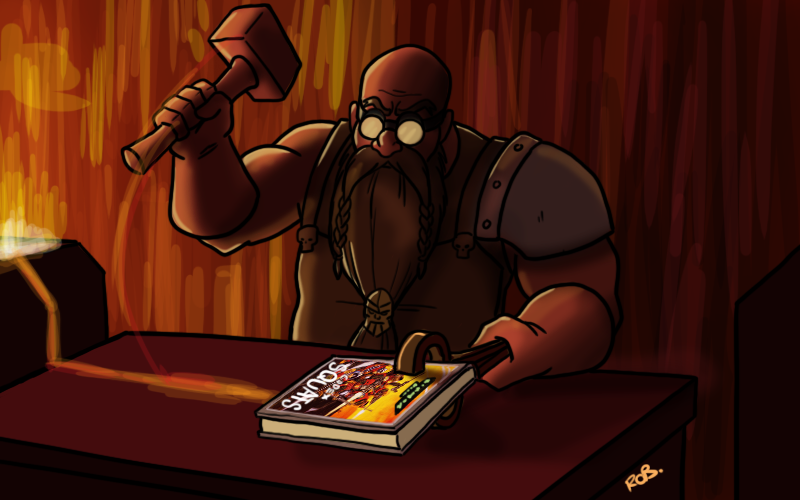The Warhammer 40,000 universe is a massive place, and the “Narrative Forge” hobby articles encourage thinking outside the box (literally) when putting models together. They aim to make hobbyists comfortable growing beyond imitating the models they see in their Codexes, and serve as a source of inspiration for anyone wanting to make an army that’s uniquely their own.
Hello, everyone! As my first foray into the world of Goonhammer articles, I wanted to immortalize a tutorial referenced by TheChirurgeon’s earlier terrain article. It was originally posted as a project log on a Facebook group of local hobbyists, then copy-pasted onto Something Awful for other people to draw from. Now it’s here, in its latest and greatest iteration. While this article uses Deathworld Forest terrain as an example, the techniques and thought processes here can be applied to any terrain project from Cityfight boards to blasted desert wastelands… so even if you’re a shameful city-slicker too cowardly to fight in deathworld jungles, read on! Addendum: (If you are a city-slicker looking to make urban terrain, be sure to check out this excellent article on the topic.)
If you’ve been in the hobby for a few years, you may remember the release of the Deathworld Forest terrain kit. Amidst an era of excellent new releases, this one was universally panned. The spindly sculpts, lurid colors, and lackluster line-of-sight-blocking capacity of the terrain made it a hard miss for almost everyone. The studio models look more at home on a Chaos Daemon World than a jungle deathworld.
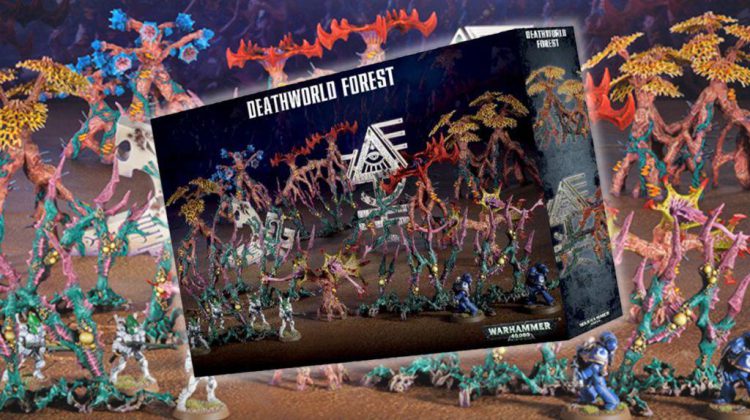
Step back, however, and look at the kit through fresh eyes. What if, instead of seeing this as an “out-of-the-box Deathworld Forest,” you instead processed this release as a “Deathworld Forest Accessory Kit”? Bizarre, dangerous flora to stick amidst your more innocuous jungle terrain and lend a subtly alien feel to your battlefield? With that mindset, the kit becomes a lot more interesting.
My goals with the Deathworld Forest kit were as follows:
- Create a durable base for each terrain piece
- Add small creatures from other model ranges to communicate a jungle crawling with life, both plant and animal
- Choose new colors for the pieces which were more in line with real-world jungles, while still looking dangerous and exotic
- Use plastic aquarium plants on the terrain bases to add volume and tie them into my existing jungle terrain
Step 1: Making the Bases
As promised, this technique will be useful for anyone embarking on a terrain project. After being failed by Google and countless online project logs, I wandered Home Depot (one of my favorite hobby activities) in search of the perfect terrain basing material… and finally found it.
For years my basing material of choice was 1/8″ MDF. Cutting this required a jigsaw and was a messy prospect for anyone not living in a log cabin, as I was at the time. After much exploration and experimentation, I discovered the simple joys of adhesive-backed vinyl tile. Make sure you buy the thick ones that don’t flex easily – you don’t want your terrain base warping. These also have a very pleasant heft to them. The tile here cost $1.09 and is a foot square:

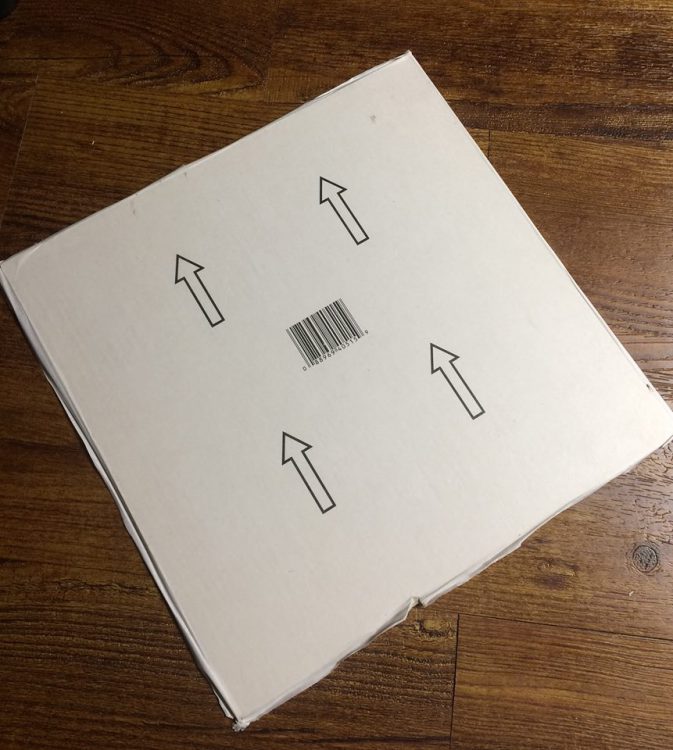
Essentially, the tile is a rugged vinyl decal with an adhesive backing. After acquiring this magical bit of material, you’re going to want to arrange your terrain on the adhesive paper side to maximize the use of the tile. This both minimizes your waste and guarantees the smallest footprint for storage if you “puzzle” your pieces together.
TheChirurgeon’s Note: I used the thinner tiles that BuffaloChicken had left over from this project and I didn’t have a problem with them warping, so if you have to go with something thinner, you’re likely still going to be OK.
HOBBY TIP: Terrain storage can be one of the most space-intensive parts of the hobby. If you have limited storage space, line your drawers or shelves with butcher paper. Spend some time “puzzling” all of your terrain together as tightly as possible. Once you’re sure you’ve found the most efficient configuration, trace the outline of each terrain piece’s footprint on the butcher paper and write which terrain piece belongs there. It’s amazing how much space this can open up, and how much time it saves when putting terrain away. If you have any small unoccupied spaces between terrain pieces, consider converting objectives on bases designed to fill those storage gaps.
After arranging your terrain on the paper side of the tile, draw an outline of the footprint you want for each base. As per the hobby tip above, if you wanted to be very efficient with your use of materials and storage, you would divide the full 1′ square tile into “puzzle pieces” that all fit back together with almost no waste. The layout below was much more casual than that:
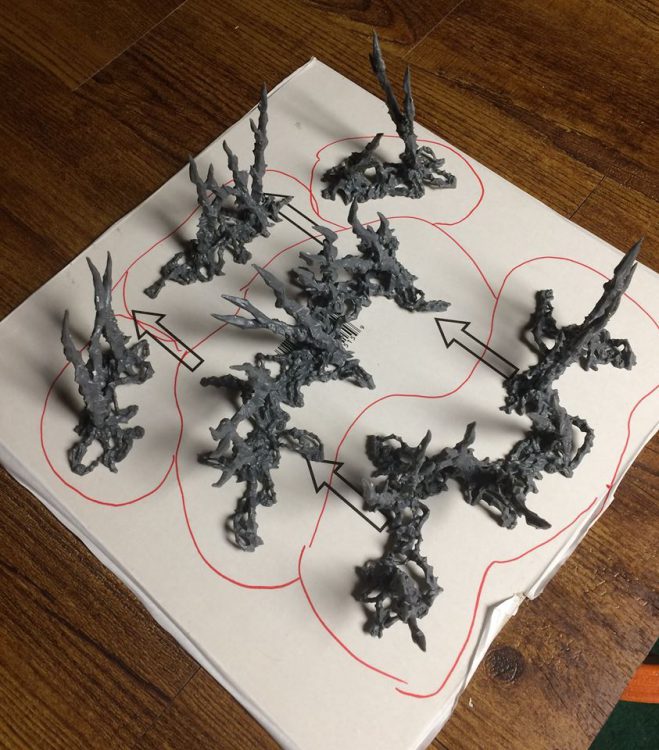
Take the terrain off, and use heavy scissors (like kitchen shears) to cut out the bases. The tile can crack if you rush this, so make slow cuts and take your time. I try to make half a cut, then move over and start a new cut that will intersect the first. That way, if the tile does split, it’ll typically join the two cuts and cause minimal damage. Making two intersecting cuts also allows the tile more flex as you work and reduces the chance of a crack happening at all. It’s also best to cut everything out rough and angular at first, then snip the rounded edges once they’re separated.
After everything is cut, mark the bases so you remember which terrain piece goes to which base.This could be handwritten, or done via doodles as below:
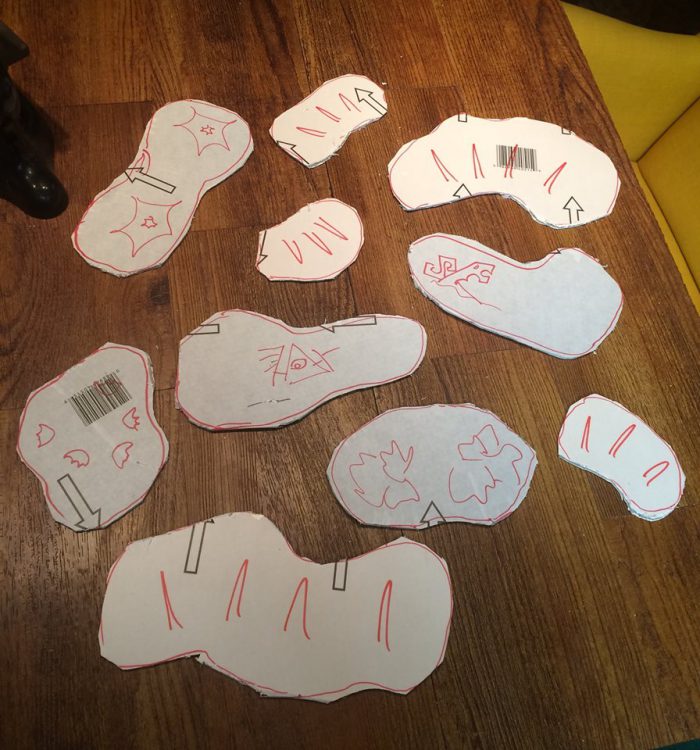
After the bases are cut out, the edges are sanded smooth. Using a cheap sheet of medium-grit sandpaper to round off the edges is totally fine, but if you have a handy orbital sander (or a lot of time to hand-sand), you can bevel the edges. This looks a lot more professional and helps the terrain visually transition into the tabletop.
Once any sanding is done, peel off the paper backing and use a glue gun (absolutely necessary terrain tool) to stick the terrain onto the adhesive side. Now the hard part is done! It’s all fun from here.
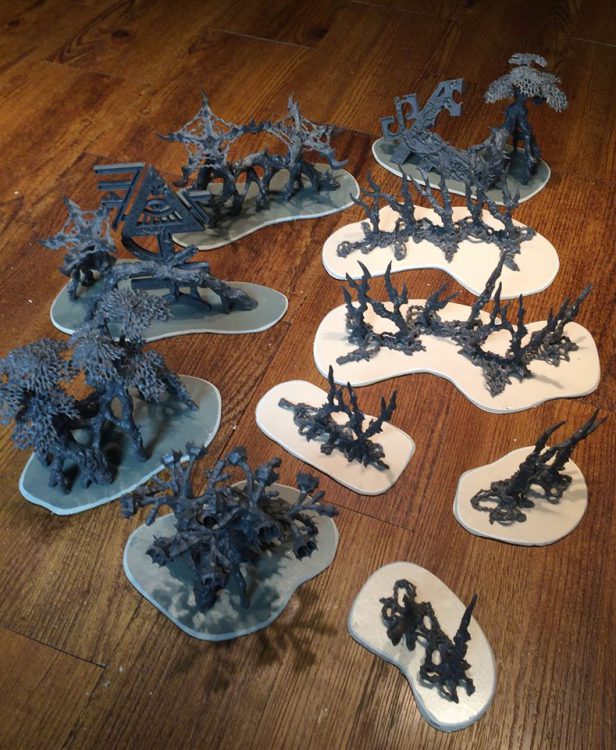
Step 2: Forging the Narrative
With the basing done, this is your opportunity to begin visually “forging the narrative” with your terrain. What this means is adding details that help tell a story. Examples of narrative-forging in terrain:
- Details that thematically tie the terrain to your personal army
- Ruins or corpses of your common opponents
- Signs of local flora or fauna
- Evidence of prior habitation – graffiti, abandoned war materiel, residential detritus, etc.
- Battle damage
For my own personal Deathworld, I wanted to hint at how monstrous the planet’s native wildlife is – and also suggest that the deadly plants are able to hold their own, with the remains of monstrous beasts impaled upon them. Dollar-store dinosaur skeletons were an easy way to do this while also tying the terrain to my Catachan army’s Jurassic Park theme. Also note the rocks hot-glued down, since almost any “wilderness” terrain looks unnatural if it’s too flat.

In my own personal bits box, I have a section of “basing odds and ends.” These are shattered bits of statues, tiny animals, plastic plants, and other things to pick through whenever doing a large base or terrain piece. For this project I chose a chest of valuables and tucked it into the embrace of a stand of deadly venomgorse – who threw it to the tree’s protection? What does it hold? Was the chest intentionally hidden within the venomgorse, or did some arcane item trapped within it prompt the growth of this unnatural plant around it?
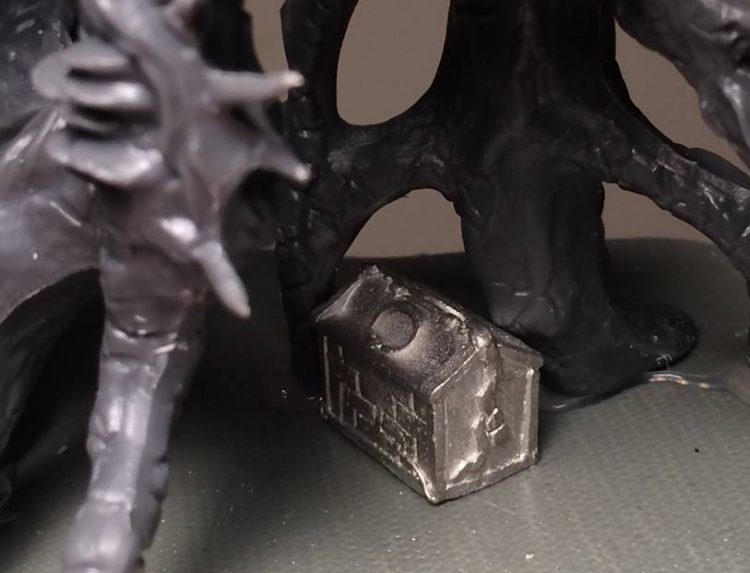
The Lizardman (Seraphon) range is an amazing source of basing bits for jungles, and the Bastiladon has yielded fragments of statuary that adorn many of my bases. I chose to have snakes pouring out of dens in the shardwrack spine bases. Do the venomous snakes have some sort of symbiotic relationship with the venomous plants, the same way poison dart frogs get their own toxicity from their diet? If a model in-game dies to a dangerous terrain effect from this model, is it due to shardwrack impalement or snakebite?

In addition to Lizardmen, the Treeman (Sylvaneth) range has tons of tiny critters perfect for terrain projects. These bits are fragile, however, and you want to be sure to glue them in a relatively protected place that doesn’t protrude from the footprint of the terrain piece. This makes them far less likely to break off during play or storage. Also take the time to pin them in place with a pin vise, or at the very least position them where their spindly bits have as much contact as possible for gluing.
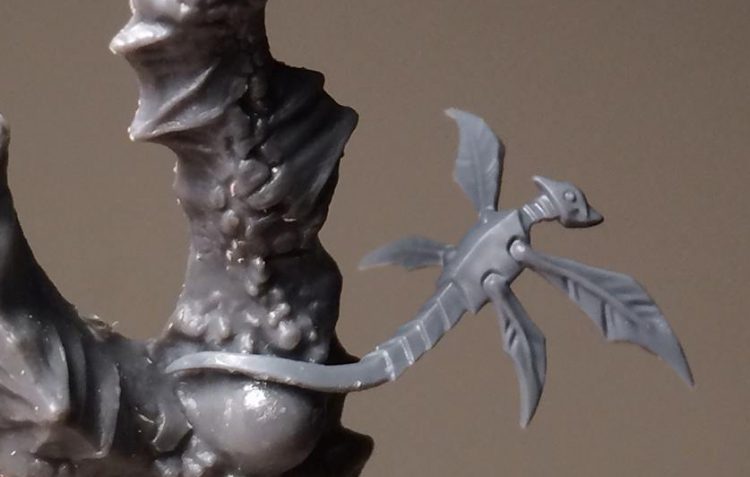
This Space Marine, donated by TheChirurgeon, was glued inside the ribcage of the tyrannosaur. I imagine he was swallowed and somehow managed to kill the beast from the inside, but perished himself in the process. Note that the ribcage was pulled out and left loose to ensure the Space Marine could be painted down the line.
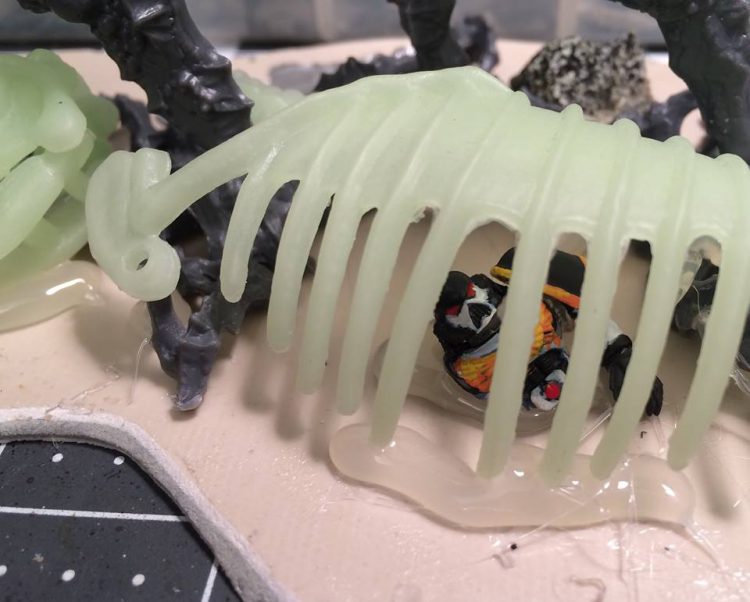
Hopefully those small examples of “narrative forging” encourage you to look at your next terrain project as an opportunity to tell some stories!
Step 3: Basing the Terrain
Take a roll of tinfoil (aluminum foil) and tear off small strips. Crumple these strips up, not too tight, and attach them to your bases – usually I glue them down, but the sticky tile makes it unnecessary in this case. The reason for the tinfoil is twofold. First, it adds a more natural uneven surface. Second, it gives a place for plastic aquarium plants to be inserted. After everything is painted, a sharp tool will be used to poke holes in the tinfoil mounds. Aquarium plant stems will be inserted into these holes and glued in place. If you don’t have tinfoil mounds, making these holes to insert plant stems will be impossible.
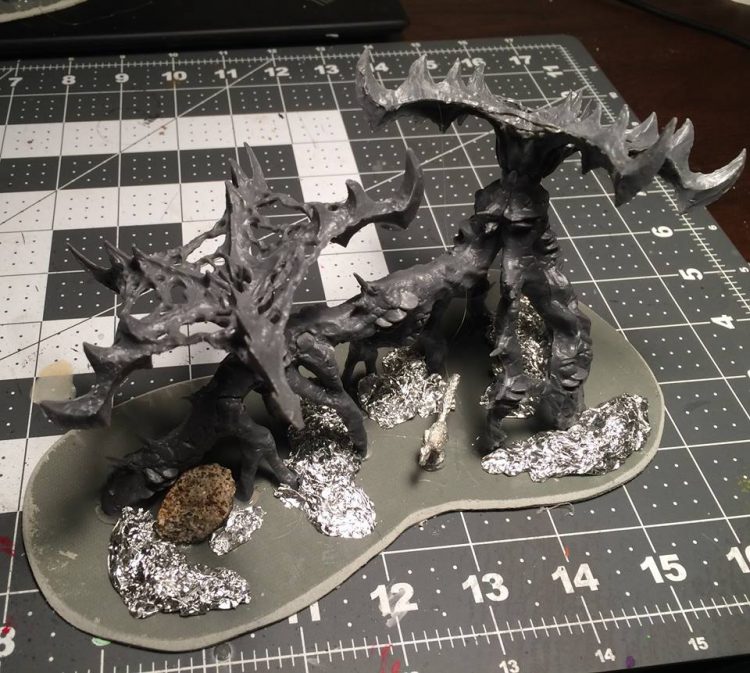
Next up is the sand. If you’re doing most standard basing techniques you should always, always, ALWAYS glue the sand on before priming. It saves a ton of time when it comes to painting, a lot of paint (sand is surprisingly absorbent), and the primer helps hold the sand together to make everything more durable. I use sand from a local lake beach – if you use sand from outdoors like this, bake it in the oven at 500 degrees for a while. This will make sure it’s completely dry and devoid of troublesome organic material.
I use cheap white dries-clear PVA glue (Elmers or the dollar store equivalent) straight from the bottle, and it always works great. Keep toothpicks on hand to spread the glue evenly and make sure it gets to all the nooks and crannies. After the first round of sand-gluing dries, inspect the terrain. Glue contracts as it dries, so some areas may have holes or gaps that need to be filled.
Do a second round of sand-gluing, dropping beads and lines of glue where more material is needed to fill gaps or smooth out transitions. In the case of these pieces, I also added more layers of glue and sand where the tree trunks or rocks meet the ground. Having the sandy ground slope up to meet the terrain looks more natural than having terrain features look like they’re sitting on top of a flat surface.
After the second round of glue/sand is dry, take a metal tool – like a greenstuff sculpting tool, though a bent paperclip will work nearly as well – and peel off any spots where sand may have been glued to the terrain by accident. Once done, shake each piece thoroughly to dislodge any remaining loose material.

Then you’re ready to prime!
Step 4: Priming and Painting
For terrain I use the same Krylon Flat Black spray paint that I use to prime all my models. For actual painting I use cheap craft store paints like Americana or Apple Barrel, which cost between $1-2 for 2oz bottles at massive chain retailers across the United States. For context, Games Workshop base colors retail at $4.55 for 12ml… that’s about $0.38/ml, compared to $0.03/ml for the craft paints. If you’ve got a big terrain project that makes a huge cost difference, and the superior quality of the GW paints isn’t necessary for simple basecoats and drybrushes. I do use GW paints when doing details or specific color matches, however.
Below you can see most of the basecoats, drybrushes, and washes done. At this point I was starting to hone in on the details like mushrooms, venom globules, flowers, spines, etc. Nowhere near finished, but they almost pass for “tabletop standard”:
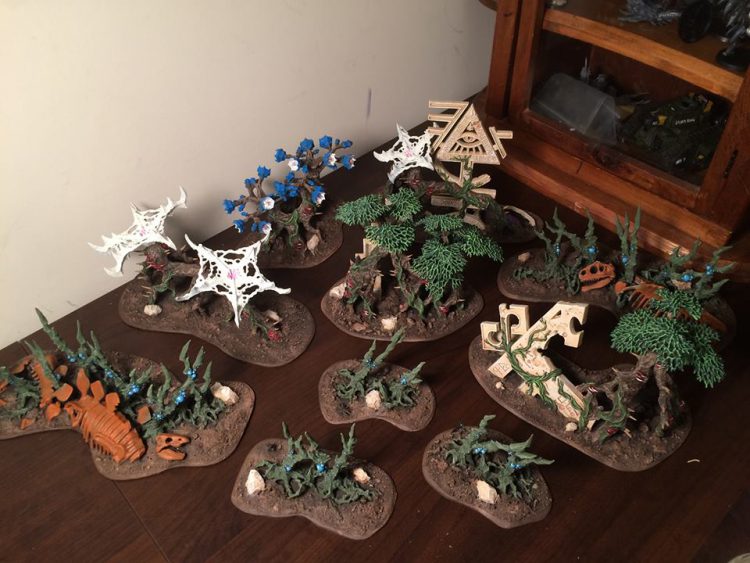
The work-in-progress stone below was done entirely with cheap craft paints – they have good coverage, work well as washes after adding water, and drybrush just as well as GW paints. Eventually the clean stone will get brown dirt streaking, greenish algal patches, and other jungle touches.
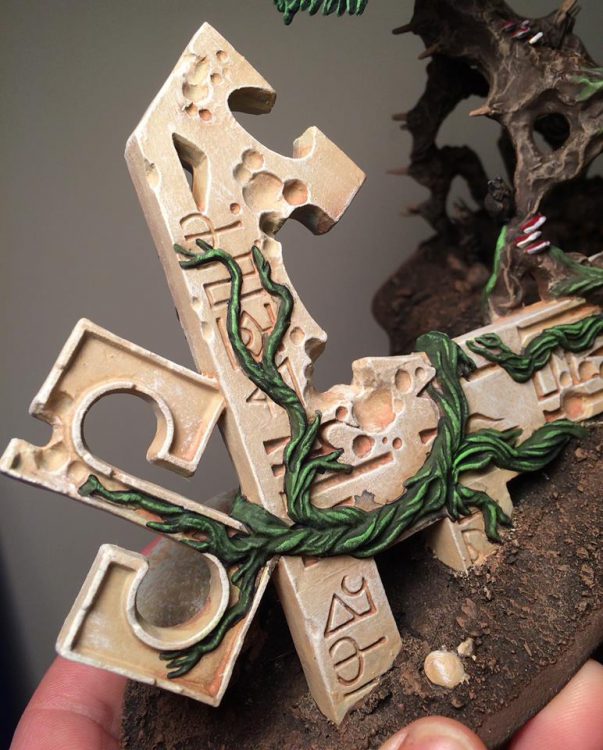
The Space Marine evolved from one of TheChirurgeon’s White Panthers to become a member of my brother’s Firedrakes Chapter. The two of us have a history of “taking trophies” from the other when making models.
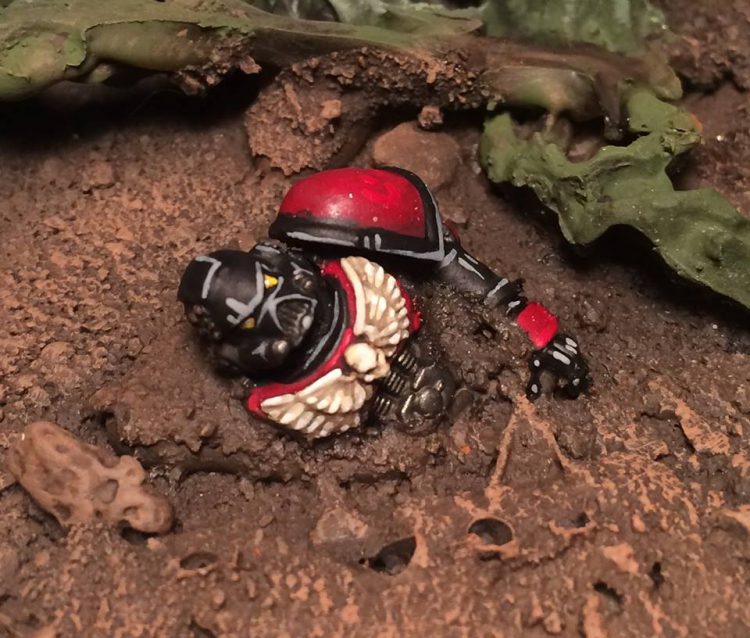
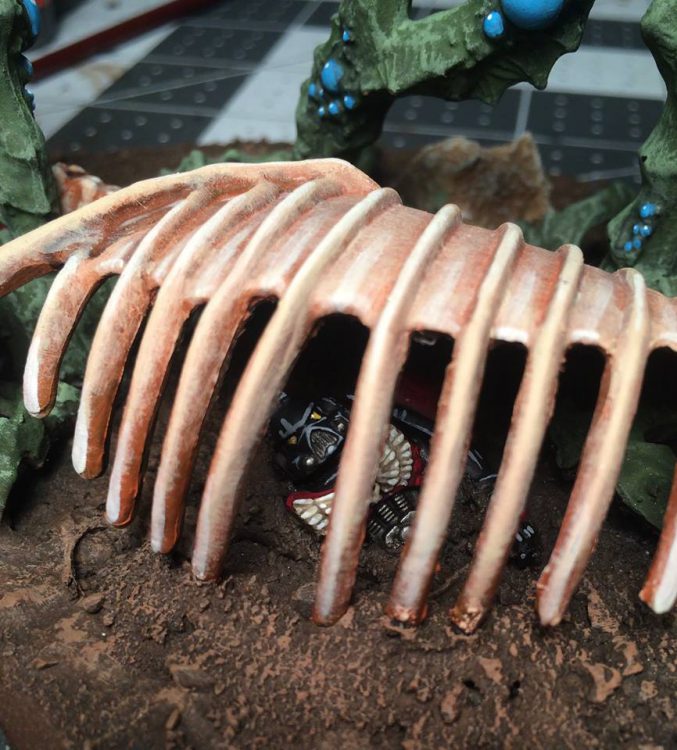
When it came to painting plants, the studio scheme was far too chaotic. It looked like the warp had overtaken a world which, while interesting, didn’t look at all like a forest or jungle as intended. I wanted something with roots (put not intended) in our natural world, but still a bit alien. I decided to use pitcher plants as inspiration. The veins, stripes, spots, and bright colors all made them look dangerous and unusual.
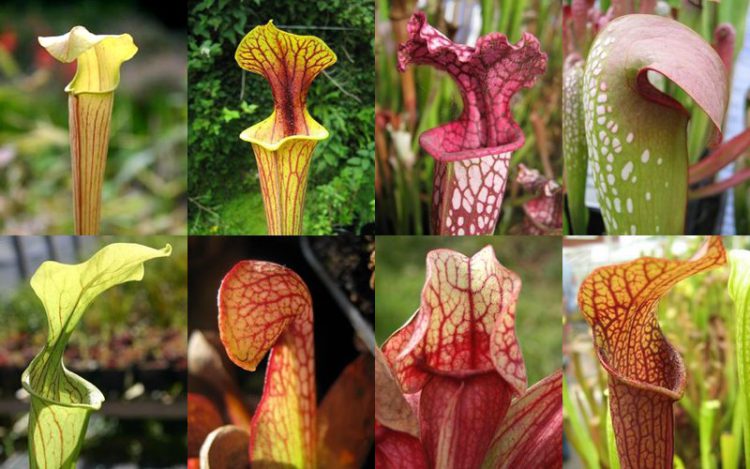
After finally settling on white flowers with purple veins for one stand of venomgorse, I debated what to do with the “teeth” ringing the maw of each flower. Highlight up to pure white? Paint brown to match the wood/thorns? My brother suggested gray, and that wound up being perfect.
All of my Tyranid models use dark gray for their sharp bits (talons and teeth), and I wanted to subtly convey that this jungle world was intertwined with them. Was this because the Tyranids consumed the jungle biomass, adopting traits of the native lifeforms? Or was it the opposite – was the presence of Tyranid spores corrupting the ecosystem, changing the native life to become more Tyranid? Here are the ways I tied the jungle colors to my Tyranids:
- Gray teeth on the carnivorous flowers, matching Tyranid teeth and claws
- Blue venom globules on the shardwrack spines, matching Tyranid toxin sacs
- Olive green as base color for the shardwrack spines, matching existing Tyranid terrain and basing details
- “Glow-in-the-dark” pale green on several of the small bugs, matching the color used for Tyranid fleshy bits
While not being in-your-face obvious, these little details make the Tyranid army feel “at home” in this environment. Other small details similarly tie the terrain to my Catachan and Chaos Daemon armies.
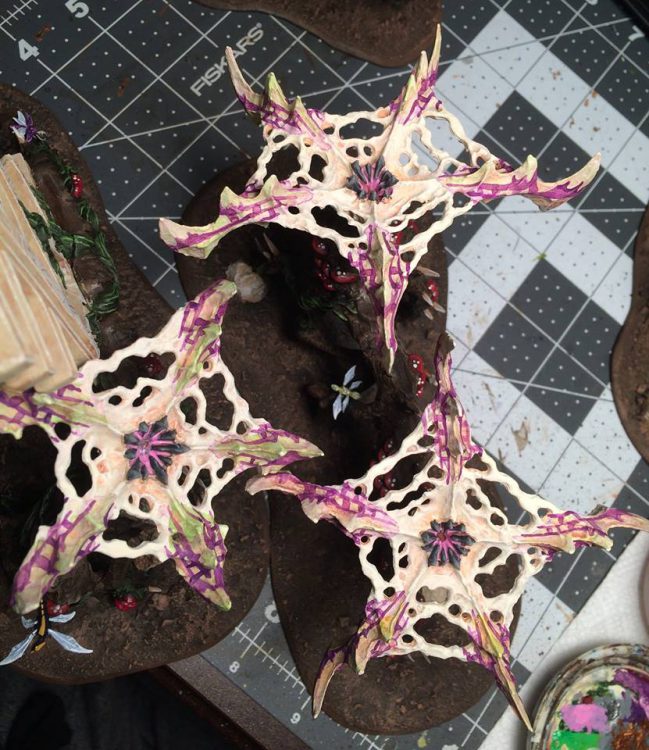
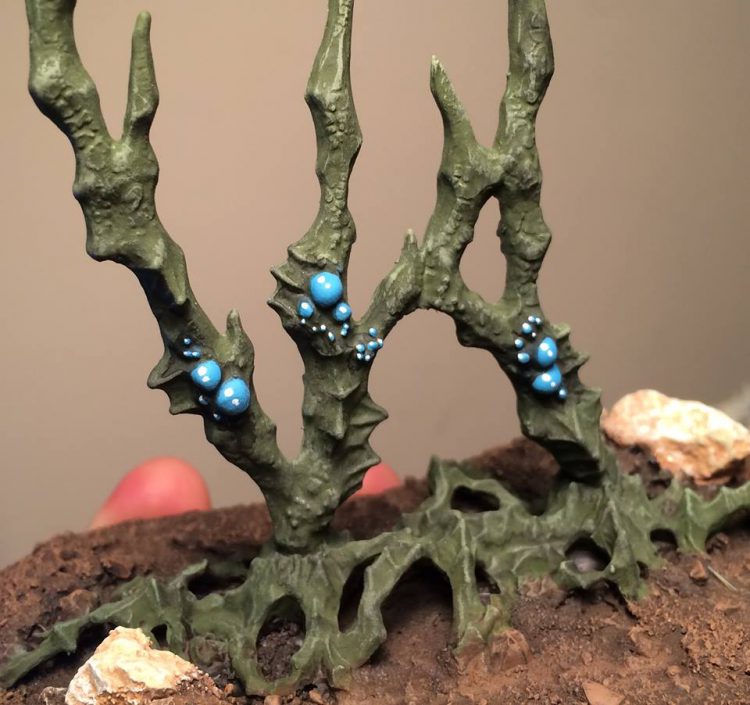
After all the painting was complete, standard green modelling flock was glued down with PVA glue in random blobs across the terrain. As you can see, however, the terrain still looks very flat and open – it doesn’t have the density, variety, and texture you’d want from a proper jungle.
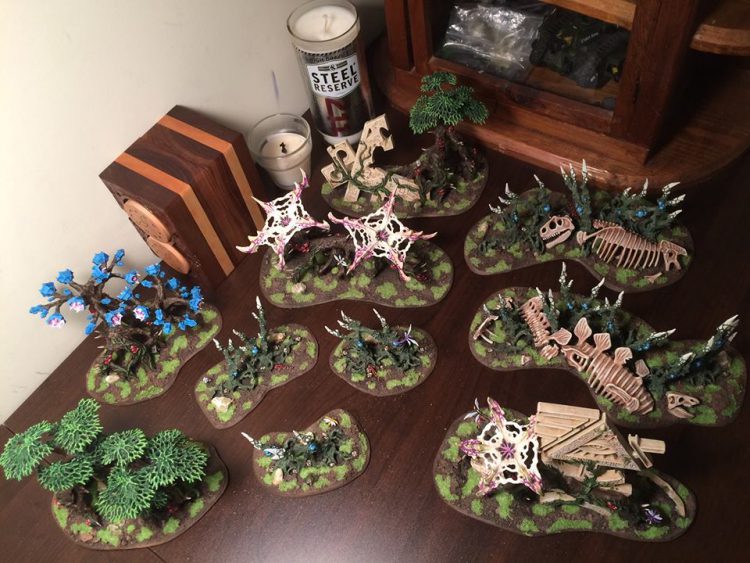
What comes next is my favorite part of any terrain project… landscaping! The list below is everything in my “jungle box”:
- Plastic aquarium or decorative plants collected over the years
- A darker, more uneven flock than the standard bright green one
- Leaf litter/scatter
- Clump foliage
- Adhesive grass/flower tufts
- Decorative dried lichen
I try to keep the plastic foliage restricted to a green-yellow palette. This keeps things from looking too visually confusing, and the recurring yellow ties the jungle to my Catachan (who wear yellow bandanas instead of the standard red).
HOBBY TIP: Even if you don’t have a jungle board, you can still have a “terrain box” to collect characterful and inspiring tidbits. An urban box might have tiny printouts of Games Workshop propoganda posters, Skaven rats, old models to chop up as statuary, and some O-scale pigeons designed for railroad dioramas. A desert box might have a ziploc baggie of pebbles, slabs of bark that look like rock formations, model cactus plants, and plastic succulent plants that often go on sale for cheap at craft stores. Keep an eye out for bits to hoard in your terrain box, and you’ll start seeing them everywhere – some of the seed pods used on my jungle terrain were collected while crawling through mud under paintball fire in a eucalyptus grove, and I once picked up shattered safety glass in a sketchy neighborhood because it would be perfect ice detailing on the base of a friend’s Imperial Knight with a snow theme. I won’t say this is all normal behavior, but it does make life more interesting!
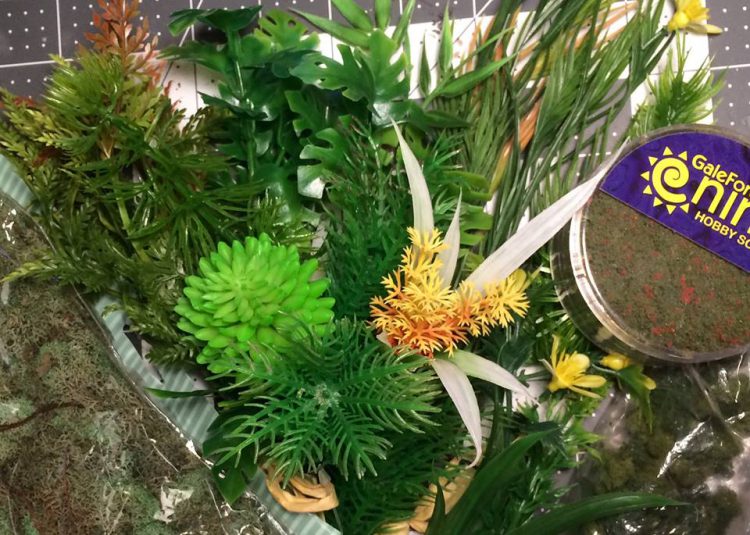
After playing around with what should go where, the plastic plants had their stems inserted into holes made in the tinfoil mounds using my pointiest greenstuff sculpting tool. They were secured with super glue, and the remaining decorative elements (lichen, flock, scatter, etc.) were secured with PVA glue.
Below is the final result, minus a bit off additional weathering. After that photo was taken the brighter stone and bone bits were given a bit more jungle weathering/streaking, as well as some tufted grass growing out of ribcages or stone cracks.
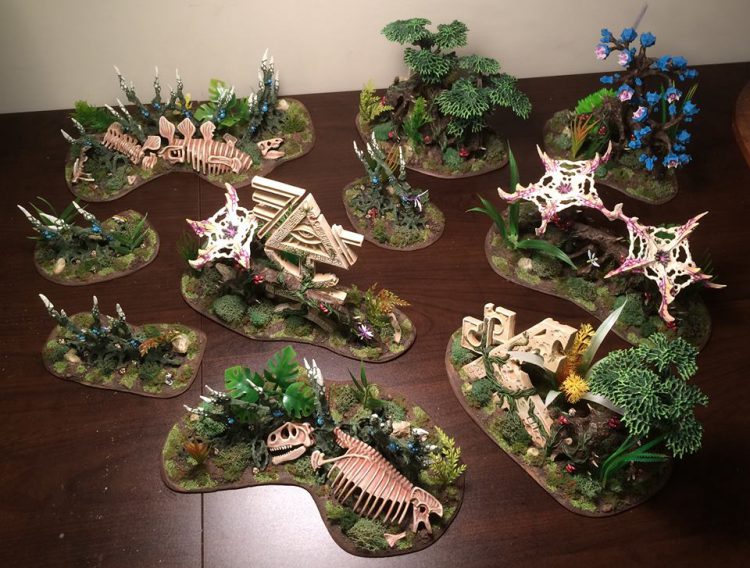

I hope this has inspired you to look at your future terrain pieces as models in their own right, worthy of attention and as capable of telling a story as any HQ or hero. Happy hobbying, and please share your results with the community – every conversion makes the Warhammer 40,000 universe grow a little larger!
P.S. – If you were wondering where the Deathworld Forest’s carnivorous scuttling Grappleweed wound up, stay tuned for a future article where I feature my “Warpwoods” Chaos Daemon army (or sneak a peek at the link below).
You can always find BuffaloChicken’s latest model photos on Instagram.
